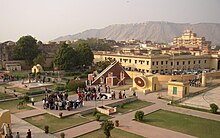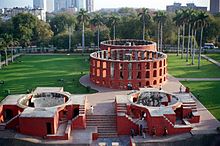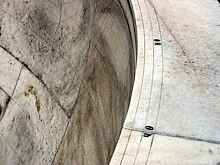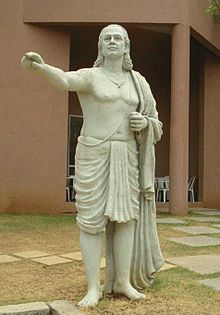Indian astronomy
Indian astronomy—the earliest textual mention of which is given in the religious literature of India (2nd millennium BCE)—became an established tradition by the 1st millennium BCE, when Jyotiṣa Vedānga and other ancillary branches of learning called Vedangas began to take shape.[1] During the following centuries a number of Indian astronomers studied various aspects of astronomical sciences and global discourse with other cultures followed.[1]
Early History
Early astronomy in India—like in other cultures— was intertwined with religion.[1] The first textual mention of astronomical concepts comes from the Vedas—religious literature of India.[1] According to Sarma (2008): "One finds in the Rigveda intelligent speculations about the genesis of the universe from nonexistence, the configuration of the universe, the spherical self-supporting earth, and the year of 360 days divided into 12 equal parts of 30 days each with a periodical intercalary month."[1] More on Indian astronomy with relation to religion is given in the section below.
The cardinal directions are found in the Śulbasūtra (1st millennium BCE), a treatise containing mathematical applications used for altar construction.[2] Mathematics and astronomical instruments were employed to calculate time after sunlight, daylight periods, computation of sunrise, computation of sunset, and general measurement of time. Ōhashi (1993) states that Jyotiṣa Vedānga astronomy gained a foothold between the 6th and the 4th centuries BCE.The common era saw the presence of numerous Siddhāntas, out of which the Surya-siddhānta was particularly notable.[3] Both the Yavanajataka and Romaka Siddhānta confirm that Indian and western astronomical sciences had been a part of a global scientific discourse (given in the section below).
The Pañcasiddhāntikā (Varahimira, 505 CE) approximates the method for determination of the meridian direction from any three positions of the shadow using Gnomon.[2] By the time of Aryabhata I the motion of planets was treated to be elliptical rather than circular.[4] Other topics included definitions of different units of time, eccentric models of planetary motion, epicyclic models of planetary motion, and planetary longitude corrections for various terrestrial locations.[4]
Relation with religion
In India astronomy and religion were interwoven during early times, beginning from the Vedic Period (2nd millennium BCE-1st millennium BCE) when the Vedas were composed.[1] Sarma (2008) notes that the Vedas are compositions of religion, and not science.[1] However, they do hold a certain amount of astronomical information.[1] The religious texts of India often contained astronomical observation for carrying out ritual associated with religion at a certain time.[1] Sarma (2008) comments on one such text:
In the Aitareya Brāhmana, we read of the moon’s monthly elongation and the cause of day and night. Seasonal and yearly sacrificial sessions helped the priests to ascertain the days of the equinoxes and solstices. The shifting of the equinoxes made the Vedic priests correspondingly shift the year backward, in tune with the accumulated precession, though the rate thereof was not envisaged. The wish to commence sacrifices at the beginning of specific constellations necessitated the identification of the constellations as fitted on the zodiacal frame. They also noticed eclipses, and identified their causes empirically.[1]
Hindus kept a pañcānga for calculations of tithi (lunar day), vāra (weekday), naksatra (asterism), and karan (half lunar day) for social and religious events.[1] Klostermaier (2003) states that: "Indian astronomers calculated the duration of one kalpa (a cycle of the universe during which all the heavenly bodies return to their original positions) to be 4,320,000,000 years."[3]
Calendars
The divisions of the year were on the basis of religious rites and seasons (Rtu).[5] The duration from mid March—Mid May was taken to be spring (vasanta), mid May—mid July: summer ("grishma"), mid July—mid September: rains (varsha), mid September—mid November: autumn, mid November—mid January: winter, mid January—mid March: dew (śiśira).[5]
In the Vedānga Jyotiṣa, the year begins with the winter solstice.[6] Hindu calendars have several eras:
- The Hindu calendar, counting from the start of the Kali Yuga, has its epoch on 18 February 3102 BC Julian (23 January 3102 BCE Gregorian).
- The Vikrama Samvat calendar, introduced about the 12th century, counts from 56-57 BCE.
- The "Saka Era", used in some Hindu calendars and in the Indian national calendar, has its epoch near the vernal equinox of year 78.
- The Saptarshi calendar traditionally has its epoch at 3076 BCE.[7]
J.A.B. van Buitenen (2008) reports on the calendars in India:
The oldest system, in many respects the basis of the classical one, is known from texts of about 1000 BC. It divides an approximate solar year of 360 days into 12 lunar months of 27 (according to the early Vedic text Taittirīya Saṃhitā 4.4.10.1–3) or 28 (according to the Atharvaveda, the fourth of the Vedas, 19.7.1.) days. The resulting discrepancy was resolved by the intercalation of a leap month every 60 months. Time was reckoned by the position marked off in constellations on the ecliptic in which the Moon rises daily in the course of one lunation (the period from New Moon to New Moon) and the Sun rises monthly in the course of one year. These constellations (nakṣatra) each measure an arc of 13° 20′ of the ecliptic circle. The positions of the Moon were directly observable, and those of the Sun inferred from the Moon's position at Full Moon, when the Sun is on the opposite side of the Moon. The position of the Sun at midnight was calculated from the nakṣatra that culminated on the meridian at that time, the Sun then being in opposition to that nakṣatra.[5]
Astronomers
| Name | Year | Contributions |
|---|---|---|
| Lagadha | 2nd-1st millennium BCE | The earliest astronomical text—named Vedānga Jyotiṣa—dates back to around 1200 BC, and details several astronomical attributes generally applied for timing social and religious events.[8] The Vedānga Jyotiṣa also details astronomical calculations, calendrical studies, and establishes rules for empirical observation.[8] Since the texts written by 1200 BCE were largely religious compositions the Vedānga Jyotiṣa has connections with Indian astrology and details several important aspects of the time and seasons, including lunar months, solar months, and their adjustment by a lunar leap month of Adhimāsa.[9] Ritus and Yugas are also described.[9] Tripathi (2008) holds that ' Twenty-seven constellations, eclipses, seven planets, and twelve signs of the zodiac were also known at that time.'[9] |
| Aryabhata | 476–550 CE | Aryabhata was the author of the Āryabhatīya and the Aryabhatasiddhanta, which, according to Hayashi (2008): 'circulated mainly in the northwest of India and, through the Sāsānian dynasty (224–651) of Iran, had a profound influence on the development of Islamic astronomy. Its contents are preserved to some extent in the works of Varahamihira (flourished c. 550), Bhaskara I (flourished c. 629), Brahmagupta (598–c. 665), and others. It is one of the earliest astronomical works to assign the start of each day to midnight.'[4] Aryabhata explicitly mentioned that the earth rotates about its axis, thereby causing what appears to be an apparent westward motion of the stars.[4] Aryabhata also mentioned that reflected sunlight is the cause behind the shining of the moon.[4] Ayrabhata's followers were particularly strong in South India, where his principles of the diurnal rotation of the earth, among others, were followed and a number of secondary works were based on them.[1] |
| Brahmagupta | 598–668 CE | Brahmasphuta-siddhanta (Correctly Established Doctrine of Brahma, 628 CE) dealt with both Indian mathematics and astronomy. Hayashi (2008) writes: 'It was translated into Arabic in Baghdad about 771 and had a major impact on Islamic mathematics and astronomy.'[10] In Khandakhadyaka (A Piece Eatable, 665 CE) Brahmagupta reinforced Aryabhata's idea of another day beginning at midnight.[10] Bahmagupta also calculated the instantaneous motion of a planet, gave correct equations for parallax, and some information related to the computation of eclipses.[1] His works introduced Indian concept of mathematics based astronomy into the Arab world.[1] |
| Varāhamihira | 505 CE | Varāhamihira was an astronomer and mathematician who studied and Indian astronomy as well as the many principles of Greek, Egyptian, and Roman astronomical sciences.[11] His Pañcasiddhāntikā is a treatise and compendium drawing from several knowledge systems.[11] |
| Bhāskara I | 629 CE | Authored the astronomical works Mahabhaskariya (Great Book of Bhaskara), Laghubhaskariya (Small Book of Bhaskara), and the Aryabhatiyabhashya (629 CE)—a commentary on the Āryabhatīya written by Aryabhata.[12] Hayashi (2008) writes 'Planetary longitudes, heliacal rising and setting of the planets, conjunctions among the planets and stars, solar and lunar eclipses, and the phases of the Moon are among the topics Bhaskara discusses in his astronomical treatises.'[12] Baskara I's works were followed by Vateśvara (880 CE), who in his eight chapter Vateśvarasiddhānta devised methods for determining the parallax in longitude directly, the motion of the equinoxes and the solstices, and the quadrant of the sun at any given time.[1] |
| Lalla | 8th century CE | Author of the Śisyadhīvrddhida (Treatise Which Expands the Intellect of Students), which corrects several assumptions of Āryabhata.[13] The Śisyadhīvrddhida of Lalla itself is divided into two parts:Grahādhyāya and Golādhyāya.[13] Grahādhyāya (Chapter I-XIII) deals with planetary calculations, determination of the mean and true planets, three problems pertaining to diurnal motion of Earth, eclipses, rising and setting of the planets, the various cusps of the moon, planetary and astral conjunctions, and complementary situations of the sun and the moon.[13] The second part—titled Golādhyāya (chapter XIV–XXII)—deals with graphical representation of planetary motion, astronomical instruments, spherics, and emphasizes on corrections and rejection of flawed principles.[13] Lalla shows influence of Āryabhata, Brahmagupta, and Bhāskara I.[13] His works were followed by later astronomers Śrīpati, Vateśvara, and Bhāskara II.[13] Lalla also authored the Siddhāntatilaka.[13] |
| Bhāskara II | 1114 CE | Authored Siddhāntaśiromaṇi (Head Jewel of Accuracy) and Karaṇakutūhala (Calculation of Astronomical Wonders) and reported on his observations of planetary positions, conjunctions, eclipses, cosmography, geography, mathematics, and astronomical equipment used in his research at the observatory in Ujjain, which he headed.[14] |
| Śrīpati | 1045 CE | Śrīpati was a astronomer and mathematician who followed the Brhmagupta school and authored the Siddhāntaśekhara (The Crest of Established Doctrines) in 20 chapters, thereby introducing several new concepts, including moon's second ineuqlity.[1][15] |
| Mahendra Suri | 14th century CE | Mahendra Suri authored the Yantra-rāja (The King of Instruments, written in 1370 CE)—a Sanskrit work on the astrolabe, itself introduced in India during the reign of the 14th century Tughlaq dynasty ruler Firuz Shah Tughluq (1351-1388 CE).[16] Suri seems to have been a Jain astronomer in the service of Firuz Shah Tughluq.[16] The 182 verse Yantra-rāja mentions the astrolabe from the first chapter onwards, and also presents a fundamental formula along with a numerical table for drawing an astrolabe although the proof itself has not been detailed.[16] Longitudes of 32 stars as well as their latitudes have also been mentioned.[16] Mahendra Suri also explained the Gnomon, equatorial co-ordinates, and elliptical co-ordinates.[16] The works of Mahendra Suri may have influenced later astronomers like Padmanābha (1423 CE)—author of the Yantra-rāja-adhikāra, the first chapter of his Yantra-kirnāvali.[16] |
| Nilakanthan Somayaji | 1444-1544 CE | In 1500, Nilakanthan Somayaji of the Kerala school of astronomy and mathematics, in his Tantrasangraha, revised Aryabhata's model for the planets Mercury and Venus. His equation of the centre for these planets remained the most accurate until the time of Johannes Kepler in the 17th century.[17] Nilakanthan Somayaji, in his Aryabhatiyabhasya, a commentary on Aryabhata's Aryabhatiya, developed his own computational system for a partially heliocentric planetary model, in which Mercury, Venus, Mars, Jupiter and Saturn orbit the Sun, which in turn orbits the Earth, similar to the Tychonic system later proposed by Tycho Brahe in the late 16th century. Nilakantha's system, however, was mathematically more effient than the Tychonic system, due to correctly taking into account the equation of the centre and latitudinal motion of Mercury and Venus. Most astronomers of the Kerala school of astronomy and mathematics who followed him accepted his planetary model.[17][18] |
| Acyuta Pisārati | 1550–1621 CE | Sphutanirnaya (Determination of True Planets) details a elliptical correction to existing notions.[19] Sphutanirnaya was later expanded to Rāśigolasphutānīti (True Longitude Computation of the Sphere of the Zodiac).[19] Another work, Karanottama deals with eclipses, complementary relationship between the sun and the moon, and 'the derivation of the mean and true planets'.[19] In Uparāgakriyākrama (Method of Computing Eclipses), Acyuta Pisārati suggests improvements in methods of calculation of eclipses.[19] |
Instruments used





Among the devices used for astronomy was Gnomon, known as Sanku, in which the shadow of a vertical rod is applied on a horizontal plane in order to ascertain the cardinal directions, the latitude of the point of observation, and the time of observation.[20] This device finds mention in the works of Varāhamihira, Āryabhata, Bhāskara, Brahmagupta, among others.[2] The Cross-staff, known as Yasti-yantra, was used by the time of Bhaskara II (1114 – 1185 CE).[20] This device could vary from a simple stick to V-shaped staffs designed specifically for determining angles with the help of a calibrated scale.[20] The clepsydra (Ghatī -yantra) was used in India for astronomical purposes until recent times.[20] Ōhashi (2008) notes that: "Several astronomers also described water-driven instruments such as the model of fighting sheep."[20]
The armillary sphere was used for observation in India since early times, and finds mention in the works of Āryabhata (476 CE).[21] The Goladīpikā—a detailed treatise dealing with globes and the armillary sphere was composed between 1380–1460 CE by Parameśvara.[21] On the subject of the usage of the armillary sphere in India, Ōhashi (2008) writes: "The Indian armillary sphere (gola-yantra) was based on equatorial coordinates, unlike the Greek armillary sphere, which was based on ecliptical coordinates, although the Indian armillary sphere also had an ecliptical hoop. Probably, the celestial coordinates of the junction stars of the lunar mansions were determined by the armillary sphere since the seventh century or so. There was also a celestial globe rotated by flowing water."[20]
An instrument invented by the mathematician and astronomer Bhaskara II (1114 – 1185 CE) consisted of a rectangular board with a pin and an index arm.[20] This device—called the Phalaka-yantra—was used to determine time from the sun's altitude.[20] The Kapālayantra was a equatorial sundial instrument used to determine the sun’s azimuth.[20] Kartarī-yantra combined two semicircular board instruments to give rise to a 'scissors instrument'.[20] Introduced from the Islamic world and first finding mention in the works of Mahendra Sūri—the court astronomer of Firuz Shah Tughluq (1309 - 1388 CE)—the astrolabe was further mentioned by Padmanābha (1423 CE) and Rāmacandra (1428 CE) as its use grew in India.[20]
Invented by Padmanābha, a nocturnal polar rotation instrument consisted of a rectangular board with a slit and a set of pointers with concentric graduated circles.[20] Time and other astronomical quantities could be calculated by adjusting the slit to the directions of α and β Ursa Minor.[20] Ōhashi (2008) further explains that: "Its backside was made as a quadrant with a plumb and an index arm. Thirty parallel lines were drawn inside the quadrant, and trigonometrical calculations were done graphically. After determining the sun’s altitude with the help of the plumb, time was calculated graphically with the help of the index arm."[20]
Ōhashi (2008) reports on the observatories constructed by Jai Singh II of Amber:
The Mahārāja of Jaipur, Sawai Jai Singh (AD 1688–1743), constructed five astronomical observatories at the beginning of the eighteenth century. The observatory in Mathura is not extant, but those in Delhi, Jaipur, Ujjain, and Banaras are. There are several huge instruments based on Hindu and Islamic astronomy. For example, the samrāt.-yantra (emperor instrument) is a huge sundial which consists of a triangular gnomon wall and a pair of quadrants toward the east and west of the gnomon wall. Time has been graduated on the quadrants.[20]
The seamless celestial globe invented in Mughal India, specifically Lahore and Kashmir, is considered to be one of the most impressive astronomical instruments and remarkable feats in metallurgy and engineering. All globes before and after this were seamed, and in the 20th century, it was believed by metallurgists to be technically impossible to create a metal globe without any seams, even with modern technology. It was in the 1980s, however, that Emilie Savage-Smith discovered several celestial globes without any seams in Lahore and Kashmir. The earliest was invented in Kashmir by Ali Kashmiri ibn Luqman in 998 AH (1589-90 CE) during Akbar the Great's reign; another was produced in 1070 AH (1659-60 CE) by Muhammad Salih Tahtawi with Arabic and Sanskrit inscriptions; and the last was produced in Lahore by a Hindu metallurgist Lala Balhumal Lahuri in 1842 during Jagatjit Singh Bahadur's reign. 21 such globes were produced, and these remain the only examples of seamless metal globes. These Mughal metallurgists developed the method of lost-wax casting in order to produce these globes.[22]
Global discourse
Indian astronomy reached China with the expansion of Buddhism during the Later Han dynasty (25–220 CE).[23] Further translation of Indian works on astronomy was completed in China by the Three Kingdoms era (220–265 CE).[23] However, the most detailed incorporation of Indian astronomy occurred only during the Tang Dynasty (618-907) when a number of Chinese scholars—such as Yi Xing— were versed both in Indian and Chinese astronomy.[23] A system of Indian astronomy was recorded in China as Jiuzhi-li (718 CE), the author of which was an Indian by the name of Qutan Xida—a translation of Devanagari Gotama Siddha—the director of the Tang dynasty's national astronomical observatory.[23]
Fragments of texts during this period indicate that Arabs adopted the sine function (inherited from Indian mathematics) instead of the chords of arc used in Hellenistic mathematics.[24] Another Indian influence was an approximate formula used for timekeeping by Muslim astronomers.[25]
Nearly a thousand years later in the 17th century, the Mughal Empire saw a synthesis between Islamic and Indian astronomy, where Islamic observational instruments were combined with Hindu computational techniques. While there appears to have been little concern for planetary theory, Muslim and Hindu astronomers in India continued to make advances in observational astronomy and produced nearly a hundred Zij treatises. Humayun built a personal observatory near Delhi, while Jahangir and Shah Jahan were also intending to build observatories but were unable to do so. After the decline of the Mughal Empire, it was a Hindu king, Jai Singh II of Amber, who attempted to revive both the Islamic and Hindu traditions of astronomy which were stagnating in his time. In the early 18th century, he built several large observatories called Yantra Mandirs in order to rival Ulugh Beg's Samarkand observatory and in order to improve on the earlier Hindu computations in the Siddhantas and Islamic observations in Zij-i-Sultani. The instruments he used were influenced by Islamic astronomy, while the computational techniques were derived from Hindu astronomy.[26][27]
Through Islamic astronomy, Indian astronomy had an influence on European astronomy via Arabic translations. During the Latin translations of the 12th century, Muhammad al-Fazari's Great Sindhind, which was based on the Surya Siddhanta and the works of Brahmagupta, was translated into Latin in 1126 and was influential at the time.[28]
Some scholars have suggested that knowledge of the results of the Kerala school of astronomy and mathematics may have been transmitted to Europe through the trade route from Kerala by traders and Jesuit missionaries.[29] Kerala was in continuous contact with China and Arabia, and Europe. The existence of circumstantial evidence[30] such as communication routes and a suitable chronology certainly make such a transmission a possibility. However, there is no direct evidence by way of relevant manuscripts that such a transmission took place.[29]
Later in the early 18th century, Jai Singh II of Amber invited European Jesuit astronomers to one of his Yantra Mandir observatories, who had bought back the astronomical tables compiled by Philippe de La Hire in 1702. After examining La Hire's work, Jai Singh concluded that the observational techniques and instruments used in European astronomy were inferior to those used in India at the time. It is uncertain whether he was aware of the Copernican Revolution via the Jesuits.[31]
See also
- History of astronomy
- Chinese astronomy
- Islamic astronomy
- Hindu calendar
- Hindu cosmology
- Hindu chronology
Notes
- ^ a b c d e f g h i j k l m n o p Sarma (2008), Astronomy in India
- ^ a b c Abraham (2008)
- ^ a b Klostermaier (2003)
- ^ a b c d e Hayashi (2008), Aryabhata I
- ^ a b c J.A.B. van Buitenen (2008)
- ^ Bryant (2001), 253
- ^ See A. Cunningham (1883), A Book of Indian Eras.
- ^ a b Subbaarayappa (1989)
- ^ a b c Tripathi (2008)
- ^ a b Hayashi (2008), Brahmagupta
- ^ a b Varāhamihira. Encyclopedia Britannica (2008)
- ^ a b Hayashi (2008), Bhaskara I
- ^ a b c d e f g Sarma (2008), Lalla
- ^ Hayashi (2008), Bhaskara II
- ^ Hayashi (2008), Shripati
- ^ a b c d e f Ōhashi (1997)
- ^ a b Joseph, 408
- ^ Ramasubramanian etc. (1994)
- ^ a b c d Sarma (2008), Acyuta Pisarati
- ^ a b c d e f g h i j k l m n o Ōhashi (2008), Astronomical Instruments in India
- ^ a b Sarma (2008), Armillary Spheres in India
- ^ Savage-Smith (1985)
- ^ a b c d See Ōhashi (2008) in Astronomy: Indian Astronomy in China.
- ^ Dallal, 162
- ^ King, 240
- ^ Sharma (1995), 8-9
- ^ Baber, 82-89
- ^ Joseph, 306
- ^ a b Almeida etc. (2001)
- ^ Raju (2001)
- ^ Baber, 89-90
References
|

